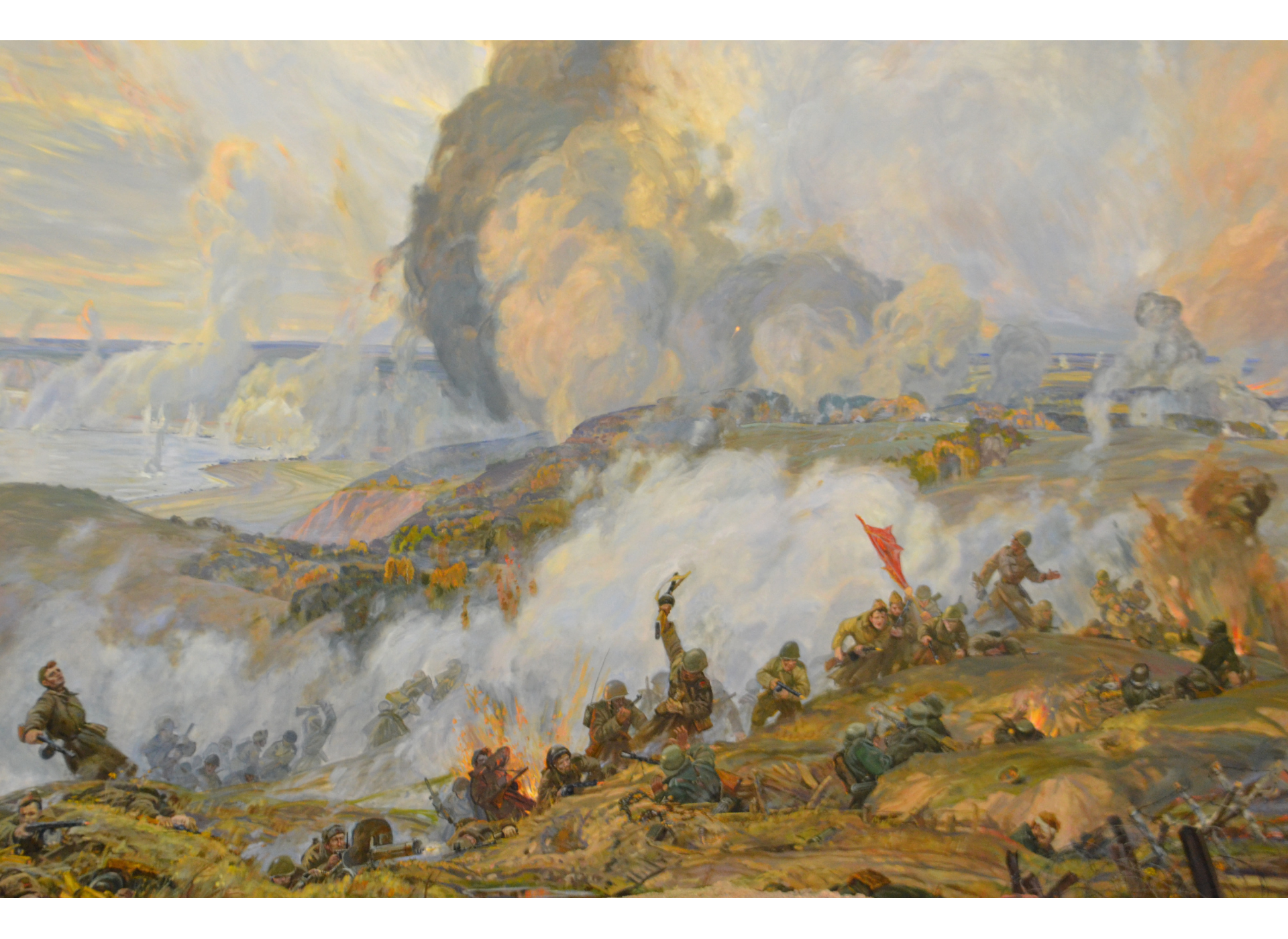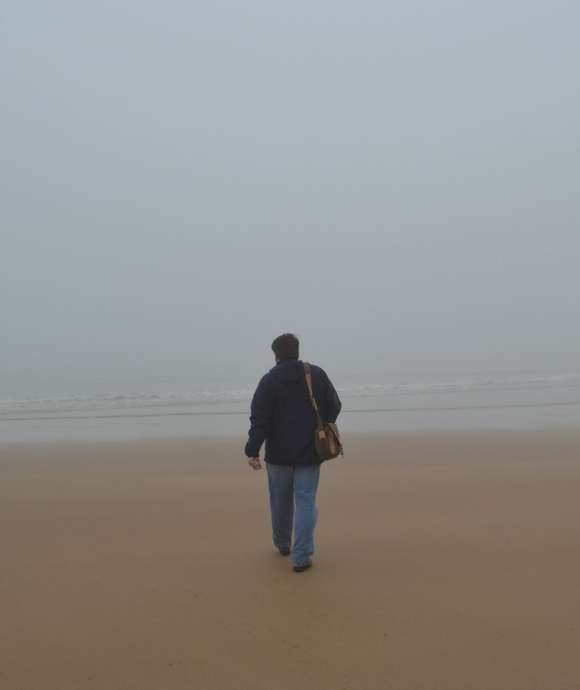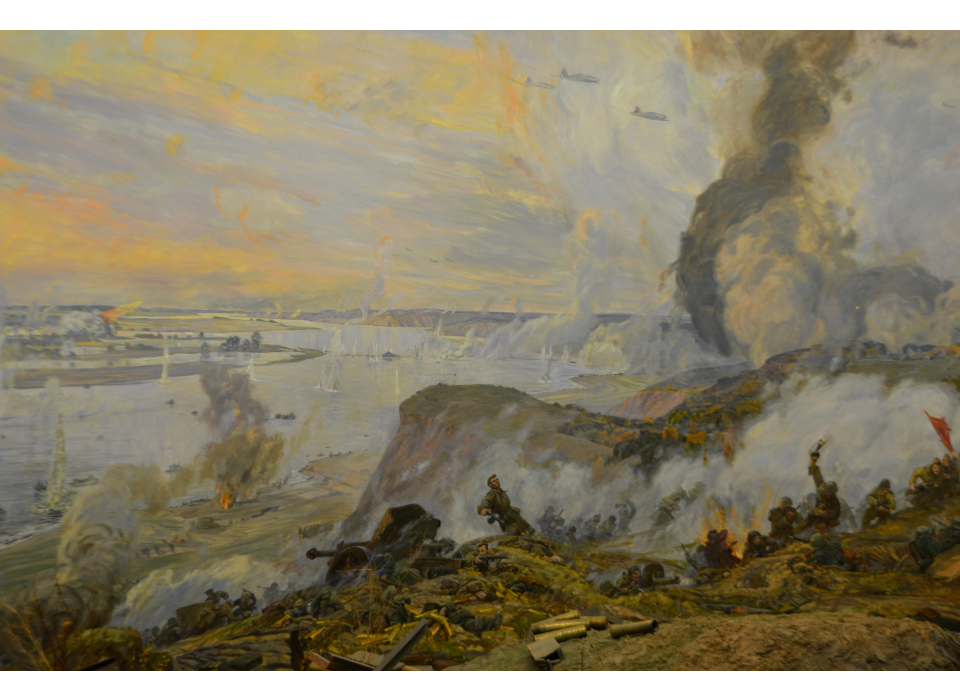The war on the eastern front between Nazi Germany and the Soviet Union was a titanic affair, and its history is unfamiliar territory to many students of World War II even today. This series of posts describing how the Great Patriotic War museum in Moscow tells the story of the war to its public through a series of diorama exhibits has presented some recognizable names and battles: the desperate fight for Moscow in 1941, the epic conflagration at Stalingrad, and the brutal siege of Leningrad. In my last post, I noted that the battle at Kursk in 1943 is less well known to western audiences than the others, even though it is notable as the largest tank battle ever fought. This is why the diorama depicting the battle to cross the Dnieper River stands out within the storyline: despite being a massive fight involving almost four million troops, it is virtually absent from most modern historical accounts.
Why does the battle for the Dnieper River deserve to stand with other, more famous battles of the eastern front? As the battle of Kursk wound down in August 1943, Hitler realized that the German forces under General von Manstein in the southern Soviet Union were vulnerable. He ordered that an “Eastern Wall” of defensive preparations be made along the Dnieper River. The Dnieper is the third largest river in Europe and was a natural boundary for German forces to fall back on following their retreat from the Volga and Stalingrad earlier in the year. For his part, Stalin wanted to capitalize on the weakened German situation and Soviet momentum through an immediate attack to the southwest to take the Ukraine back. Indeed, the Red Army launched a massive offensive involving over 2.6 million Soviet troops was launched on August 26, 1943, along a broad front some 870 miles long (1,400 kilometers) in breadth. The Soviet High Command (Stavka) realized this strategy would cost them more casualties than a deep penetration and encirclement of the German forces, it would also allow the Soviets to disrupt German supply lines by taking advantage of partisan warfare behind the German front. For its part, the German SS implemented a scorched earth policy, destroying all in its path as they fell back towards the Dnieper.
The fighting was fierce. Despite being severely outnumbered, the Germans contested every town and city, deploying rear guards in towns and on hills that slowed the Soviet advance and costing large casualties. On September 15, Hitler ordered that Army Group South fall back to the Dnieper defense line. The German fortifications were on the east bank of the Dnieper, while the high, steep embankments on the west side of the river meant that it would present additional challenges for the Soviets in establishing bridgeheads across the river and lodgments on the western side. But the Soviets established their first bridgehead on the northern end of the front on September 22, where the Dnieper and Pripyat rivers merged, and by the end of the month they had carved out no fewer than 23 bridgeheads.
The Soviets paid dearly in blood for gaining the lodgments. By early October, most Soviet divisions were at less than half of their original strength in the north, but their success allowed the Soviets to launch an offensive along the southern Dnieper which netted them a swift advance. The Soviets achieved lodgments along the west bank of the southern Dnieper approximately 300 kilometers long (186 miles), including some lodgments 80 kilometers deep (49 miles). By the end of 1943, the push to the Dnieper had regained strategic control of the Crimea and Ukraine and set the stage for the Red Army to advance into Eastern Europe from the southern part of the front. The cost was 1.6 million Soviet casualties, including over 417,000 killed or missing in action—once again, as at the battle of Kursk which preceded the massive push for the Dnieper, more Soviet troops were lost than the United States suffered during the entire war.

It is against this imposing history that the diorama at the Great Patriotic War museum in Moscow recreates the great fight to cross the Dnieper. In the background of the view, the surface of the Dnieper is pockmarked with shells and artillery fire, aircraft streak overhead, and fire and smoke signify the struggle to gain a lodgment on the far west bank. Amongst spent artillery shells in the foreground, German and Soviet troops clash as the Germans attempt to hold their Eastern Wall along the Dnieper’s east bank. The viewer gets a sense that the Soviets are overwhelming the enemy with their superior numbers, but also a sense of the heavy cost. Centered amidst the chaos of battle, a single Soviet soldier falls in the moment of death, an image somewhat reminiscent of the famous photograph by Robert Capa from the Spanish Civil War a few years earlier. But to the fallen soldier’s right, another Soviet soldier brandishes a machine gun with his raised right arm, ready to strike a German with the butt of the gun. Given the coloration of his weapon and posture of the soldier, at first glance, I thought that the soldier might actually be carrying a torch. The symbolism is even more striking when one gazes further right at a surging band of Soviet soldiers attacking the German line beneath the banner of the Soviet flag, its bright red literally fluttering like a torch against the grey smoke of the battle.
The historical reality of the moment met the metaphor. By the end of 1943, the Germans could still fight, but could not recover or hold the invaded territory they had rolled across in 1941-1942. The Red Army was now ready to push the German invader not only out of Soviet territory but to force its way into a new empire in Eastern Europe on the road to Berlin. This will be the subject of my next post.
Note: This is the fifth of eight posts about the Great Patriotic War Museum in Moscow. Read Part One. Part Two. Part Three. Part Four. Part Six. Part Seven. Part Eight.

"No matter one’s age, travel is a unique and exciting educational experience. In my work, I have had the opportunity to reflect on history, events, and people in the places where they experienced life. Through the viewfinder, we can not only find history and perspective, but create memory, and evoke our evergreen past."
– Keith Huxen, PhD, Senior Director of Research and History, The National WWII Museum
Keith Huxen
Keith is the former Senior Director of Research and History in the Institute for the Study of War and Democracy at The National WWII Museum.
Cite this article:
MLA Citation:
APA Citation:
Chicago Style Citation:





![Max Fuchs, New York City cantor, sings as Rabbi Sydney [sic] Lefkowitz, Richmond, VA, conducts the first Jewish services from Germany.](/sites/default/files/styles/max_650x650/public/2025-10/image1.jpg)



